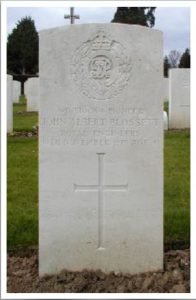Royal Engineers

John Albert Blossett was born at Hereford in 1877, the son of James and Emma Blossett.
Prior to joining the Army his trade was a chef.
On 30 March 1902 he married Martha Jane Miles at St Martin’s Church, Hereford. She was five years younger than him and on 29 May 1902 she gave birth to their first child, a daughter, Florence May, at Hereford. A further child, a son, Reginald John Barker, was born on 23 December 1912, by which time the family was living at 65 Magdala Road, Gloucester.
John attested under ‘Lord Derby’s Scheme’ or the Group Scheme on 9 December 1915. This scheme still maintained an element of voluntary enlistment but was in reality only a step away from the compulsory conscription that followed it. He was considered fully fit for general service and being a married man in his late thirties, under the terms of the scheme, mobilisation was deferred by several months and did not take place until 15 June 1916.
His initial posting was to the 11th Battalion of the Gloucestershire Regiment (number 29516), based at Belhus Park near Grays in Essex.
On 1 September 1916 this battalion was renamed to the 16th Training Reserve Battalion and was located at Seaford, Sussex.
On 16 November 1916 he left the training battalion upon being posted to the 1st Battalion (‘A’ Company), Rifle Brigade (number 27889), whom he joined in France the following day. He remained with the British Expeditionary Force (BEF) in France until 6 March 1917. He then returned to the UK, where he was located from 7 March 1917 until 12 April 1918. During this time some was spent at a Command Depot at Tipperary, Ireland. On 30 August 1917 he joined the 5th Battalion, Rifle Brigade based at the Isle of Sheppey, Kent, before transferring to the Royal Engineers (Railway Command Troop Depot) at Bordon, Hampshire on 15 March 1918 and he stayed here and at the nearby Longmoor Camp until 12 April 1918. He then went back to France, remaining there until 11 August 1918.
On 12 August 1918 he returned to the UK, where he remained until his discharge on 30 June 1919. In all he served for three years 16 days and in BEF for 231 days. During his time with the Royal Engineers he appears to have served with the Inland Waterways and Docks section and also the 3rd Fort Construction Company.
Fortunately both his Service and Pension Records have survived, so we have useful information on both his movement between units and also his medical record. He was granted furlough between 24 April and 1 May 1917, having suffered a frost bitten finger. Between 22 May and 6 August 1917 he was treated at the Military Hospital at Tipperary for a condition called ‘iritis’ (now called ‘uveitis’), which affect his right eye. This was probably the reason for him being re-categorised as Category C2 fitness. On 31 July 1918, whilst in France, he was admitted to a Base Hospital with debility, diagnosed as nephritis, or inflammation of the kidneys. He was sent back to the UK, to the Red Cross Hospital at Gloucester, where he suffered an epileptic fit.
His mental condition continued to deteriorate and in May 1919 he was diagnosed with dementia and his discharge from the Army followed on 30 June. On 16 July 1919 a medical board recommended that he be consigned to an asylum. He was awarded a Silver War Badge, to mark his discharge following military service.
He died at Gloucester on 14 November 1919 and the records known as ‘Soldiers Effects’ for him state unsympathetically that he was discharged ‘as insane’. He was aged 41. A death notice in the Gloucestershire Echo of 20 November 1919 states that he died at 65 Magdala Road, Gloucester, however, death could well have been at the Coney Hill Mental Hospital. He was buried in Gloucester Old Cemetery, where a CWGC headstone marks his grave. He is commemorated on the Gloucester War Memorial. His widow never re-married and died at Hereford in 1955, aged 73.
Researched by Graham Adams 22 January 2016
